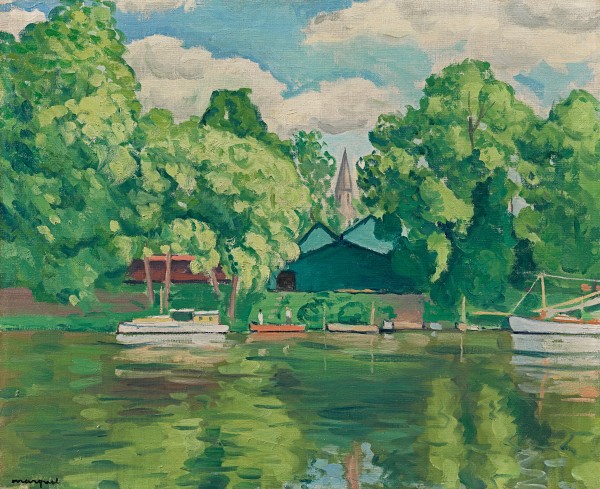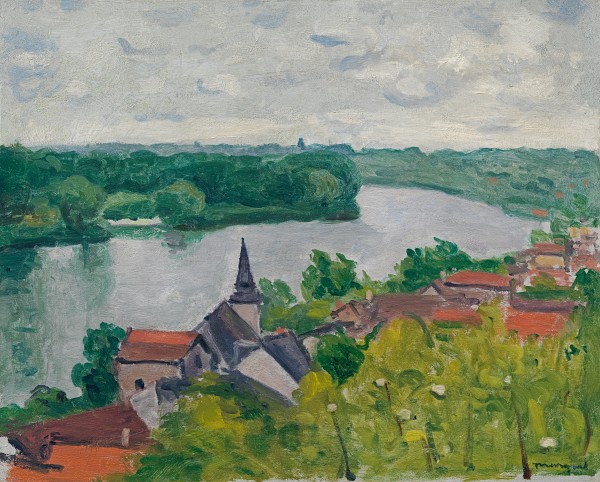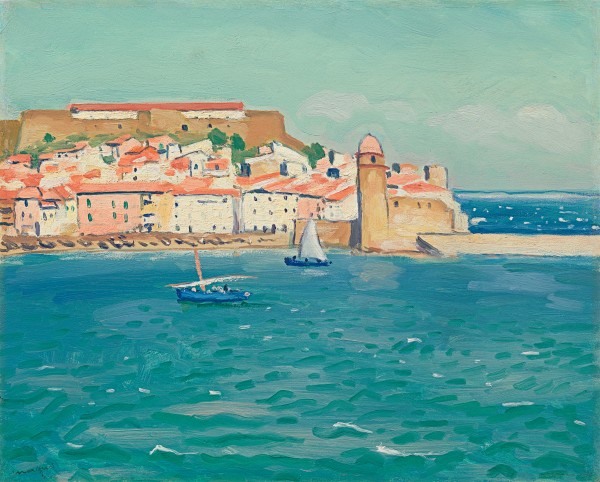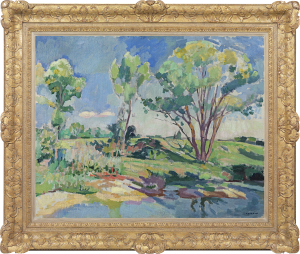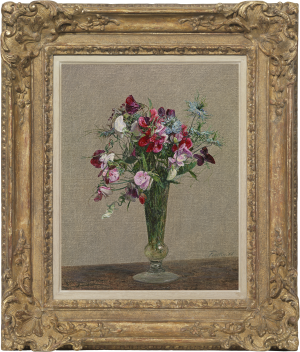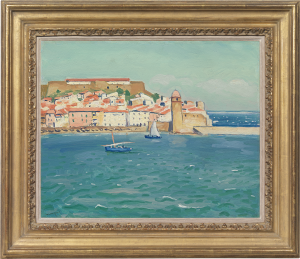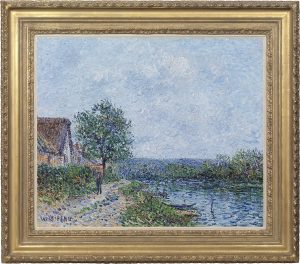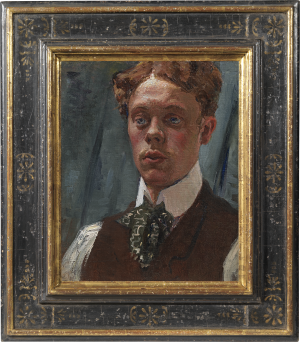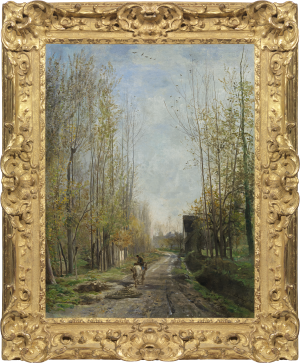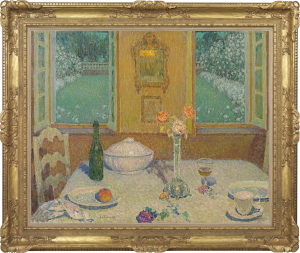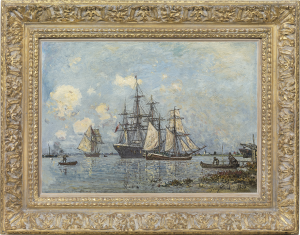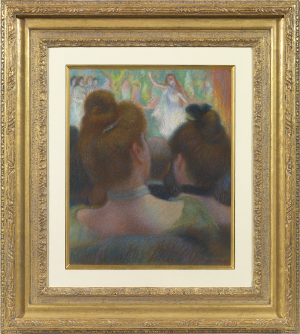
Click on image to enlarge
Albert Marquet
Poissy, le lavoir
Oil on panel: 13 x 16.1 (in) / 33 x 41 (cm)
Signed lower left: marquet
This artwork is for sale.
Please contact us on: +44 (0)20 7493 3939.
Email us
ALBERT MARQUET
Bordeaux 1875 - 1947 Paris
Ref: CB 232
Poissy, le lavoir
Signed lower left: marquet
Oil on panel: 13 x 16 1/8 in / 33 x 41 cm
Frame size: 19 ½ x 22 ½ in / 49.5 x 57.2 cm
Painted in 1929
Provenance:
Galerie Druet, Paris, acquired from the artist 8th November 1929, inv. no.12669;
Mme Lemière, acquired from Galerie Druet on 6th December 1929
Jacques Rodrigues-Henriques, Paris
Sale Galerie Motte, Palace Hôtel St-Moritz, Geneva, 13th February 1976, lot 62, illus. (as La Seine à Poissy – Le lavoir);
where acquired by a private collector, Switzerland;
by descent
Exhibited:
Lausanne, Fondation de l’Hermitage, Albert Marquet, 12th February-5th June 1988, no.63, illus. in colour (lent by a private collector, Geneva)
Albert Marquet travelling exhibition, Tokyo, Isetan Museum, 26th September-22nd October 1991; Nagoya, Matsuzakaya Museum, 31st October-17th November 1991; Ibaraki, Modern Art Museum, 11th January-23rd February 1992, p.70, no.45, illus.
Certificate of authenticity from Jean-Claude Martinet[1], Paris, 29th November 1976
To be included in the forthcoming Digital Catalogue Raisonné of the work of Albert Marquet currently being prepared by the Wildenstein Plattner Institute, Inc., ref.
Albert Marquet lived on the banks of the Seine most of his life and became celebrated for his sensitive observation of Paris and its river. Fascinated by water, ports and coastline, he was also an inveterate traveller, visiting England, the USSR and North Africa, among other places, as well as exploring his native France.
As a young man in the studio of Gustave Moreau, Marquet forged friendships with Camoin, Rouault, Manguin and Matisse. They burst upon the Salon d’Automne in 1905 with vibrant colours and bold brushwork, leading a critic to dub them ‘Fauves’ (Wild Beasts). Marquet was closely associated with this group in the early years of the twentieth century. By the time that this painting was made, in 1929, Marquet had forged a highly individual manner influenced by aspects of Impressionism, the work of Cézanne and the graceful economy of Japanese landscape painting.
Marquet spent the summer of 1929 in a house on Ile Migneaux, a long, thin strip of land on a bend of the Seine opposite the town of Poissy. The leafy island had been developed in the early twentieth century by the hotelier-restaurateur Léon Chouquet. A bridge from the Poissy side encouraged the building of villas in that fanciful interpretation of vernacular architecture – complete with turrets and half-timbering – typical of holiday villas at that time[2].
The garden of Marquet’s villa ran down to the banks of the Seine. This view is painted from the boat which was kept moored at the bottom of the garden. Floating in the river, Marquet has produced a composition of dreamlike tranquillity. He captures the subtle radiance of the light of northern France and the lush, fresh greens of early summer. Marquet depicts an arm of the Seine at Poissy with an old bateau lavoir or laundry boat on the left. These often-ramshackle buildings were communal laundries, usually set over a stream or floating on a river, taking advantage of the water supply in the days before extensive domestic plumbing. Their picturesque quality and usefulness as a repoussoir in river scenes meant that lavoirs frequently appear in the work of Impressionists such as Monet and Sisley.
Marquet’s pea-green lavoir harmonizes with the trees lining the river, which display a myriad of hues from deep emerald green in the shadows, to brilliant yellow-green on the sunlit vegetation. The greens contrast with the tranquil grey of the water, the mushroom-coloured stucco of the building and the subdued sky. The crisp geometry of the buildings, outlined in black, and the perfect reflection of the landscape in the river, infuse the painting with a classical serenity influenced by Japanese prints.
Laundry boat in Toulouse, 1901.
Photograph by Eugène Troutat.
Musée de Toulouse.
ALBERT MARQUET
Bordeaux 1875 - 1947 Paris
Albert Marquet was born in Bordeaux in 1875, the son of a railway employee. He went to Paris to study at the Ecole des Arts Décoratifs at the age of fifteen. Six years later he joined the studio of Gustave Moreau, where he met and forged lasting friendships with Camoin, Rouault, Manguin and Matisse. During this period Marquet began to use the vibrant colours and bold brushwork that is characteristic of the Fauves with whom he was closely associated. He exhibited at Berthe Weill and the Galerie Druet, Paris from 1902 and from 1903 at the Salon d’Automne.
After 1907 Marquet’s interest in Japonisme resulted in more sober works. He travelled extensively, frequently leaving his apartment on the banks of the Seine to visit England, Germany, Italy, the USSR, Scandinavia and North Africa, where he spent the years of the Second World War. He met his wife Marcelle Martinet, whom he married in 1923, on his first stay in Algiers in 1920.
The most profound influence on his work is that of the Impressionists and Post-Impressionists, notably Paul Cézanne. Like the Impressionists his favourite subjects were port scenes, beaches, quaysides, river views and coastal villages; he was particularly fascinated by the effect of light on water.
André Rouveyre, a fellow student in Gustave Moreau’s atelier, wrote: ‘Marquet reigns over the kingdom of light. The light that shines on the things of this world, of course, but also that which belongs to his pictures alone: a strangely regal quality that comes from his sensitivity and wisdom. Skies, hills, houses, streets all bathe in his subtle but intense lights’.
The work of Albert Marquet is represented in the Musée d’Orsay, Paris; the Centre Pompidou, Paris; the Musée des Beaux-Arts, La Rochelle; the Musée de Grenoble; the Hermitage, St Petersburg; Tate, London; the Metropolitan Museum of Art, New York; the Art Institute of Chicago and the National Gallery of Art, Washington DC.
[1] Nephew of Marquet’s wife and author of the first volume of the catalogue raisonné of his work.
[2] See Chronos Poissy, Jean-Bernard Rigaudeau et. al., ‘Ile de Migneaux: 100 ans d’urbanisation’, no.48, spring 2003, pp.2-21.

